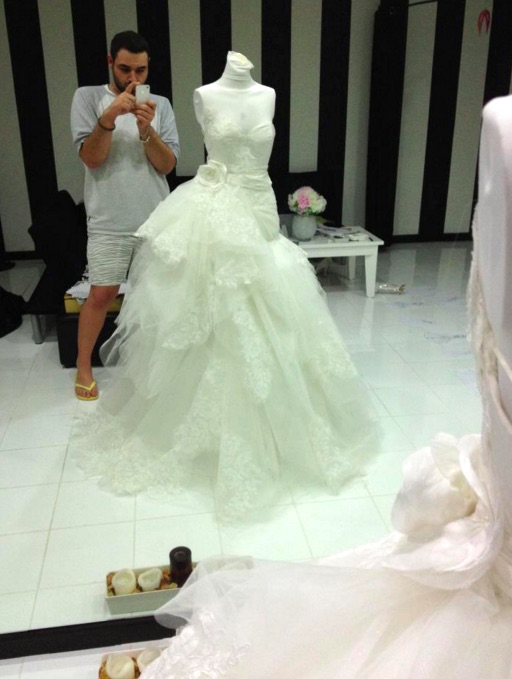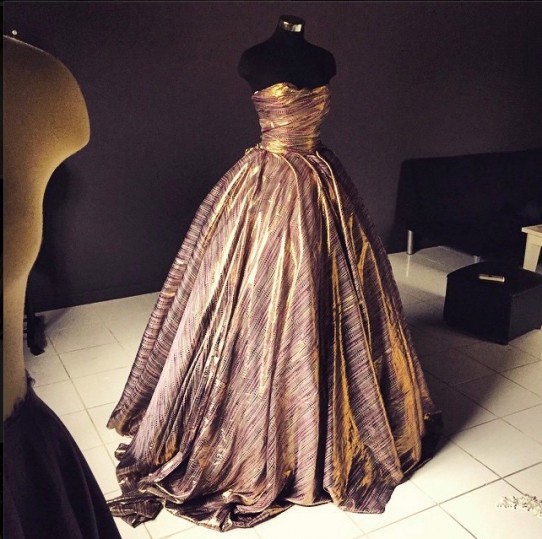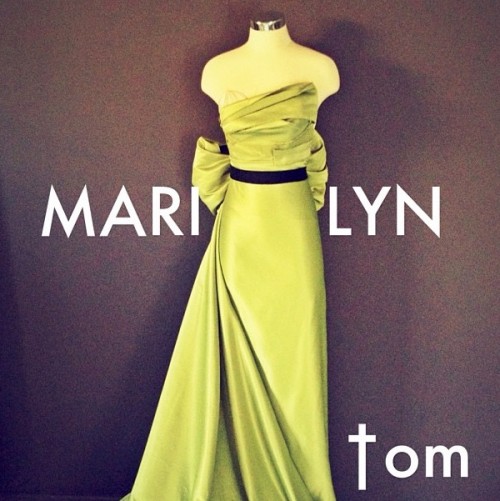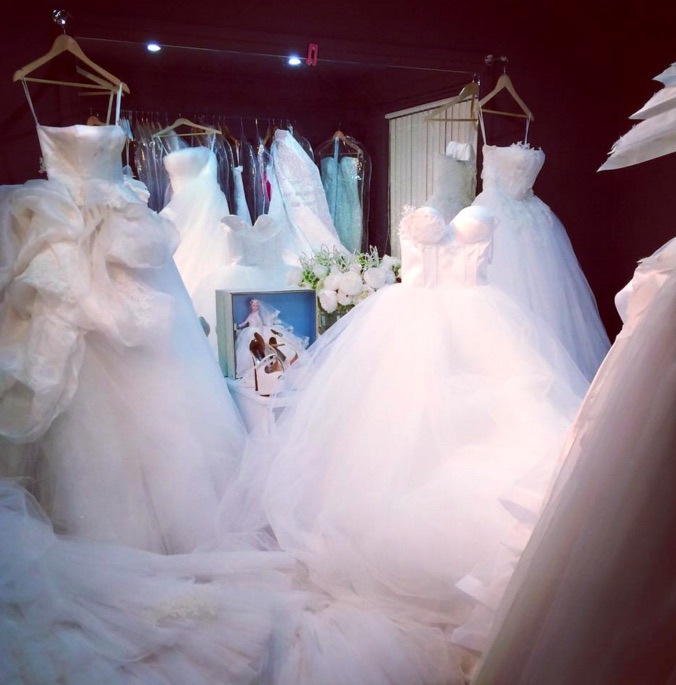Tucked away in a quiet street in Edensor Park in the Western Suburbs of Sydney is an unremarkable house. Its aesthetic appearance is no different to that of neighbouring residences—same brickwork, same driveway, same parched lawn.
But behind its simple façade lies the studio of a creative genius. Seemingly endless lengths of white tulle, coloured silk and delicate lace adorn the various mannequins placed around the room. Intricate sketches and designs are strewn around a tabletop, begging to be brought to life. This is the house and studio of rising Australian wedding dress and evening gown designer, Thomas Lazar, reports Bernadette Anvia.
 “Tom,” he says. “Call me Tom.”
“Tom,” he says. “Call me Tom.”
Lazar is much like the house in which he resides. He prefers to dress casually—socks and thongs are his staple—with nothing pretentious about his style or mannerisms. But behind the humble and laidback demeanor is a fiercely determined and innovative mind.
At only 27 years of age, Lazar has transformed his life from one of predicted failure to overwhelming triumph. It has been a transition filled and fuelled by criticisms from high school teachers, community members, and plagued by the inevitable self-doubt.
As the son of an esteemed Assyrian Orthodox Priest, Lazar experienced immense pressure while growing up to follow in his father’s footsteps and commit to a life of service.
“Being watched and being expected to follow in your dad’s footsteps and become a priest, that would be hard for anyone,” he says.
“I’d always have to be very careful of what I’d do or say and it was actually kind of hard to be content and be myself because it wasn’t very accepted for the people in our community for me to be as creative and as loud as I wanted to be.”
Ironically, while his father’s prominent position in the Assyrian community was the source of Lazar’s sense of discomfort and constraint, it was also where his love for fashion and design began.
“Because of my father, we were invited to weddings week after week and as my father never went to weddings, my mother always took me with her,” he says.
“I was a pageboy for more than 17 weddings and a groomsman a number of times so I became fascinated by the fashion of the weddings.”
School was no less of a struggle for Lazar. Classes in mathematics or literacy held no interest for a creative teenager who preferred spending time drawing and designing. In year 10, he was forced to drop out of school after he wasted exam time drawing a wedding dress on the back of his test paper.
“The teacher showed my paper to my mum when she was called into school and she said ‘your son didn’t answer any of the questions in the whole hour but he drew a dress, so I think it’s time for him to leave and work or he has to repeat,’” he says.
“My mum was disappointed,” he admits. “I think any parent would be disappointed, though.”
 After some time spent working at Hungry Jack’s, Lazar finally persuaded his parents to pay his way through the Whitehouse Institute of Design.
After some time spent working at Hungry Jack’s, Lazar finally persuaded his parents to pay his way through the Whitehouse Institute of Design.
“I thought this [designing] is something I could do, maybe I could make dresses myself in the way I think they should look,” he says.
It was not, however, a place where he fitted in. Living in the Western suburbs of Sydney and not sporting any brand names, Lazar felt he stuck out like a sore thumb.
“People in my class were all there from North Sydney with their Louis Vuitton bags and I was there with my thongs and my socks,” he says.
After only two weeks at Whitehouse and with considerably emptier pockets (his parents spent a non-refundable $13, 000 on his course), Lazar dropped out.
“I just felt that most of the fashion students there were concerned with the brands and being famous—I didn’t expect to be famous or rich, I just wanted to be doing what I love,” he says.
“I left, having never done fashion before, and taught my self everything.”
Lazar takes a short reflective pause.
“I just jumped straight into the deep end. The deep end is best.”
Through the help of the Internet and a number of YouTube sewing videos—“you got to love the Internet,” he declares—Lazar gained all the information he needed to set himself up.
During his early days of designing, Lazar undertook all his sewing himself. Nowadays, the increased demand for one of his gowns has meant that Lazar cannot cope with the orders on his own.
“I now have several workers who sew for me—if you have sixty-plus brides a year you can’t do it all yourself—no one could I think,” he says. “I still do the decorating and embellishments—so I do the embroidery, the beading and the lacework.”
It has now been seven years since Lazar started designing and creating his own wedding gowns. What began as a single dress made for one of his friends has now turned into a hugely profitable business with a considerably lengthy waiting list for one of Lazar’s gowns. Through word of mouth, his client base has grown from friends and family members in his local area to international clients from Canada and New Zealand.
What began as a hobby frowned upon has now become a fruitful career embraced by his community and family members.
“One hundred per cent I think they are accepting me for what I am doing—definitely,” he says.
“People are going to my mum and dad now trying to get bookings with me. My parents are very overwhelmed about everything.”
 This year, Lazar debuted his gowns at Fashion Palette alongside the work of other Australian designers, including Leona Edmiston. Lazar’s debut featured an array of voluminous white wedding gowns and evening dresses in various hues of lilac and lime green. If he could describe his designs in two words, they would be “loud” and “bold”.
This year, Lazar debuted his gowns at Fashion Palette alongside the work of other Australian designers, including Leona Edmiston. Lazar’s debut featured an array of voluminous white wedding gowns and evening dresses in various hues of lilac and lime green. If he could describe his designs in two words, they would be “loud” and “bold”.
“Bold, bold, bold,” he laughingly repeats.
To claim it has been easy for Lazar in the deep end would not be entirely correct. The stress of needing to design something new and radically different so his designs can stand out in a hugely competitive fashion industry has often been quite intense.
“There have been moments where I’ve been like ‘I can’t do this, I need to stop’ because of the pressure,” he admits.
And the rise of social media sites like Instagram has added to the pressure.
“It’s not like it used to be where you make something and the only people to see the dress were the people attending the function or the wedding or the fashion show—now photos are everywhere and they’re for the whole world,” he says. “To make something different, you need to create something that’s different.”
But designing will always be an outlet for Lazar’s creativity, and a means through which to express himself.
“Being able to be creative, and being able to do your own thing, is the most amazing, soothing, calming thing you could possibly do,” he says.
“To be honest with you, I don’t know where I get inspiration from. I get inspired from something as small as a tissue, for example. I will take that tissue and manipulate it and play with it until I have something. I’ll create my own stuff with a mannequin—I’ll pull out a couple of fabrics and whatever works. I just dream it and it comes out randomly.”
Prone as he is to favour the deep end, Lazar does not intend to stop there. He plans to have his own independent fashion show next year, where he will debut 32 new gowns.
Plans for the opening of a boutique are in development, although he’s not able to share many details. His dream achievement, he confesses, would be to have Britney Spears wearing one of his gowns.
“I’m happy with whoever comes in to wear my dresses,” he says. “I do have a couple of celebrities wearing my stuff very, very soon. I can’t say who because I’ve signed all these papers.”
As for whether he will be broadening his clothing range, it’s not a possibility to be ruled out.
“I was always eager to do something more out of the boundaries, but for a lot of my stuff I haven’t been able to do that so much with my clients because some of them are a bit hesitant,” he says.
The success of Lazar is not merely personal. As the son of migrants from Iraq who raised Lazar in the Western Suburbs of Sydney, he is aware that his rise heralds much-needed diversity in the fashion industry.
“I hope that I am changing how we see fashion, firstly for people in my Assyrian community and then for people in the local Western Suburbs area,” he says.
“There are heaps of talented people around here—anyone can break into the industry. You just have to have that open mind, that urge, that passion to survive and succeed.”
Lazar laughs before he adds his last requirement: “Never sleeping.”





